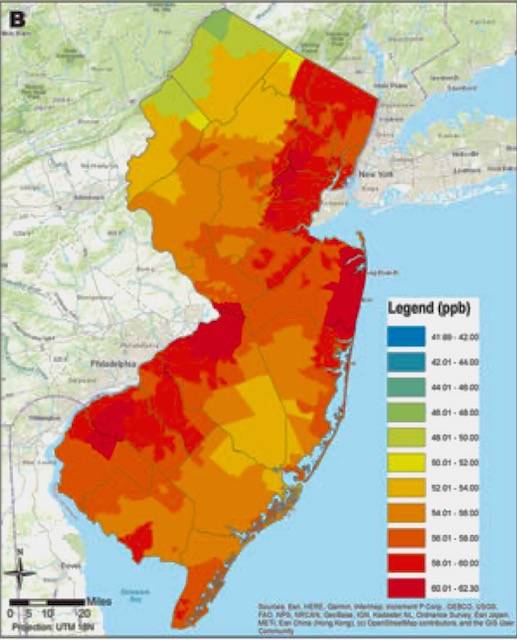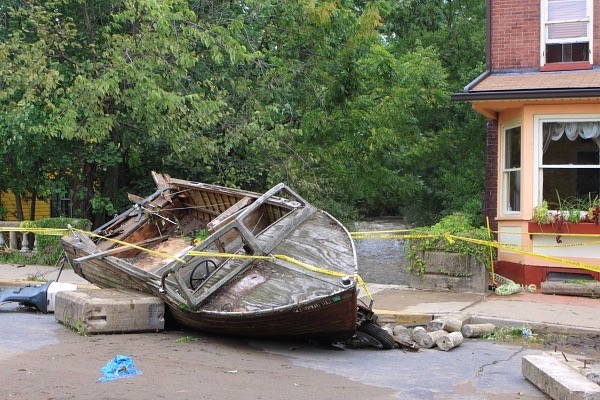NJ Builders And Municipalities Ignore Climate Risks – Continue To Develop In High Flood Hazard Locations
Murphy DEP Continues To Abdicate And Rely On Failed Local Land Use Plans
Market Failure And Perverse Local Incentives Demand State Regulation
NJ Spotlight just wrote another stunningly misleading climate – land use story, basically repeating the myth that local land use controls are effective in adapting to the climate emergency, despite blatant contradictions with their own prior reporting and sources in the story itself.
Amazingly, today’s reporting comes after it took NJ Spotlight – based on the biased opinions of the corporate planning group NJ Future – almost 2 years of warehouse development stories to finally report that reliance on local “home rule” and the voluntary NJ State Plan is “doomed to fail”. (NJ Spotlight, 9/12/22)
As an author of the 1986 State Planning Act, Gilbert said he and other drafters were told by the administration at the time to remove language that would dilute home-rule power while building up regional or statewide authority over the planning process.
“The governor and legislative leaders knew that to convince the collective towns and cities to give up this power, they would have to offer something in return. Furthering the public good was not enough.”
The latest attempt to establish statewide or regional planning policy is doomed to fail for the same reason, Gilbert argued.
“Hope springs eternal among planners,” he said. “But we don’t seem to be willing to learn from our mistakes. So here we have again another toothless wish list of wonderful things for towns to do.”
After almost 30 years of lies by State Plan supporters, it took almost 40 years for the media to tell the truth and report that the toothless State Plan was INTENTIONALLY “doomed to fail”.
Equally amazing, today’s climate – land use story – which focuses on land use planning and local property taxes – comes literally in the wake of Gov. Jim Florio’s death.
Not surprisingly, news coverage of Florio’s legacy failed to mention his outgoing State of the State address in 1994, which highlighted and warned about the voluntary State Plan, the dangers of “home rule”, and over-reliance on local property taxes. Florio said:
During the past few years, one very important tool for fighting property taxes and promoting responsible development has been working its way to completion. The State Plan was begun in 1985 by Governor Kean, and finally approved in 1992.
It’s the backbone of the effort I’m talking about today. My last contribution to that effort took place this morning, when I signed an Executive Order that will end the piecemeal implementation of our new State Plan. It requires all agencies of state government to immediately begin to coordinate their actions with each other and with the objectives of the Plan.
To fix those problems, Florio’s final action as Gov. was to issue Executive Order #109 to put State teeth in the State Plan – another key legacy that went unreported.
(Worse, in prior coverage of Florio’s legacy, NJ Spotlight not only failed to report this legacy, they provide a platform for Governors Christie Whitman and Tom Kean – the very people who reversed Florio’s accomplishments.)
So, with that context in mind, what did NJ Spotlight do?
They AGAIN relied on NJ Future as an expert source and AGAIN emphasized failed voluntary local planning and AGAIN let Murphy DEP off the hook for continuing abdication of DEP’s legal and moral responsibilities.
Do people forget that Murphy DEP Commissioner actually said THIS on the record? (NJ Spotlight, 10/14/20)
Although developers and builders fear the new rules will tighten limits on where they can build in coastal and inland areas, the regulations are unlikely to do that, LaTourette said in an interview with NJ Spotlight News. …
“We’re not at a point, nor do we think it’s our role, to tell people: ‘Don’t build here, you shouldn’t build there, you can’t do that,’” LaTourette said. “It is about making folks assess their risk and recognize the risk they are taking on. We are not saying: ‘You cannot build in a future flood-risk area.’ We’re saying that in a future flood-risk area, you need to at least do what you do now in an existing flood-risk area, which is: assess the risk, and notice that risk. It will forever live in the deed record of that property.”
“Not our role”. “Deed record” buyer beware. The Market rules. Right.
So let me explain today’s continuing media and regulatory failures.
In a rambling and convoluted complex climate story titled “How climate change could sink NJ’s tax base — and not just at the Shore”, the reader has to dig for and infer the lede – which is that real estate market profits and perverse local tax incentives are ignoring and compounding climate risks by continuing to develop in highly inappropriate locations, all while the Murphy DEP continues to abdicate a State responsibility.
Spotlight reported:
While few municipalities in New Jersey have started to plan for this impact, it’s something that Stratton, the Hoboken official, views as a future threat that’s commingled in a ball of financial risks associated with climate change.[…]
But that doesn’t mean local leaders are ready to make major changes. On the contrary, ongoing coastal development in many parts of the state will increase the value of private property and the scale of property-tax revenues jeopardized by rising seas.
“I haven’t seen it affecting development, new development or redevelopment in any way,” Herrington said. [Herrington is at the Urban Coast Institute at Monmouth University]
Despite this municipal planning failure, market failure, and perverse economic incentives, the Murphy DEP has done nothing but talk:
A slow state response
Statewide efforts are underway, but those processes tend to move slowly. New Jersey’s Department of Environmental Protection announced an emergency rulemaking push following last year’s devastation from Ida, an attempt to create new restrictions on development in floodplains. But that effort has ground to a halt, with the state facing heavy pushback from business groups
So, what are the solutions? What level of government has the lead responsibility? Again they go local:
Kasabach sees coastal communities as having three choices as sea level rise eats away at properties.
And who is framing these failed local alternatives?
Kasabach [NJ Future] said it’s imperative the state move forward with the proposed floodplain rule.
“That’s going to give local officials more support to be able to make those tough planning decisions about areas where they’re not going to reinvest infrastructure dollars, where they’re not going to encourage redevelopment to take place,” Kasabach said.
Meanwhile, a recently enacted state law requires each of the state’s 564 municipalities to incorporate a climate change risk assessment into their master plan updates. Kasabach called the law a game-changer.
“As towns are starting to realize they need to meet this requirement, they’re starting to have the right kinds of conversations about their land use (and) future projections about what things are going to look like,” Kasabach said.
Let’s break that down:
1) NJ Spotlight again relies on Kasabach of NJ Future, which is the same corporate planning outfit that misled them for 2 years on the warehouse story by emphasizing failed local planning and the “doomed to fail” toothless State Plan.
Instead of accurately describing NJ Future as a private corporate planning group, they misled readers with this:
New Jersey Future, a nonprofit group focused on urban design.
NJ Future describes themselves:
New Jersey Future has:
- Served as chief advocate for the adoption and implementation of the State Development and Redevelopment Plan, New Jersey’s smart growth blueprint for revitalizing communities and protecting natural resources.
After decades of misleading the people of NJ about the intentionally, by design, “doomed to fail” toothless State Plan, and then again repeating those same lies on the warehouse problems, NJ Future’s credibility should be zero and they should not be the sole source to outline alternatives. Period.
2) Note how Kasaback contextualized DEP’s regulations as merely support for local planning. He says it’s the municipalities that are to make the “tough planning decisions”, thereby again localizing a State responsibility.
3) In this story itself, NJ Future Kasaback’s emphasis on municipal planning is contradicted by other sources, who say municipalities are doing very little or nothing.
4) As I explained in detail, the law Kasaback mentions is NOT a “game changer”.
That law (according to NJ Spotlight’s spin):
requires each of the state’s 564 municipalities to incorporate a climate change risk assessment into their master plan updates. Kasabach called the law a game-changer.
Just like the voluntary State Plan is toothless, so too are Municipal Master Plans toothless, and for the same legal reasons.
Under NJ’s Municipal Land Use Law, the local Master Plan is NOT enforceable. There is no, what is called “mandatory conformity” requirement.
The local zoning code, which is enforceable and controls development, is not required to conform with the Master Plan.
So a “climate change risk assessment” sounds good, but it is a meaningless exercise, merely – to quote Jim Gilbert –
“another toothless wish list of wonderful things for towns to do“.
[Update: a well informed reader sent me this note on the “Climate Change Risk Assessment”: (my emphasis)
It only applies when a town redoes its master plan which is rare every 20 years or more – its not included the Periodic MP review which is every 10 years but its not mandatory- also there no mandatory implementation of the plan or zone changes required.
[End Note: With respect to the Hoboken sea wall solutions NJ Spotlight cheerleads for and why they will fail, see also:


